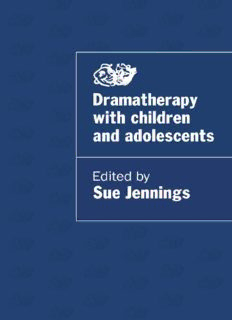
Dramatherapy with Children and Adolescents PDF
Preview Dramatherapy with Children and Adolescents
Dramatherapy with children and adolescents The development of the dramatic imagination is the means by which we can consider the implications of our actions. Failure to provide dramatic structure for the dramatic imagination can result in chaos, and confusion and imagination out of control leads to chaos in the community. Thus the role of drama in the healthy development of every individual is increas ingly recognized, and especially its importance in working with children and adolescents. Dramatherapy with Children and Adolescents addresses in practical ways direct approaches to work with both individuals and groups and provides firm guidelines and theoretical frameworks for therapeutic intervention. The first three chapters are concerned with the play of young children from contrasting approaches. The next three look at the context of drama therapy work and some specific issues of theory and practice. These are followed by three chapters describing specific applications of drama therapy with different groups of adolescents. The book closes with three chapters which look at the development processes of the dramatherapist and the family, and the themes of psychopathology and creativity. The contributors - from Britain, Denmark, Greece, Israel, the Nether lands and the USA - draw on a wide background of experience in using drama with children. Dramatherapy with Children and Adolescents will be invaluable to all professionals who work with children, including social workers, probation officers, nurses and teachers, as well as dramatherapists and play therapists. Sue Jennings is Senior Research Fellow at the London Hospital Medical College and a dramatherapy consultant to courses in Israel, Norway, Denmark and Greece. This page intentionally left blank Dramatherapy with children and adolescents Edited by Sue Jennings R Routledge Taylor & Francis Croup LONDON AND NEW YORK First published 1995 by Routledge 27 Church Road, Hove, East Sussex, BN3 2FA Simultaneously published in the USA and Canada by Routledge 270 Madison Avenue, New York NY 10016 Transferred to Digital Printing 2010 Routledge is an imprint of the Taylor & Francis Group, an Informa business © 1995 Sue Jennings, selection and editorial matter; individual chapters, the contributors Typeset in Times by J&L Composition Ltd, Filey, North Yorkshire All rights reserved. No part of this book may be reprinted or reproduced or utilized in any form or by any electronic, mechanical, or other means, now known or hereafter invented, including photocopying and recording, or in any information storage or retrieval system, without permission in writing from the publishers. British Library Cataloguing in Publication Data A catalogue record for this book is available from the British Library. Library of Congress Cataloguing in Publication Data A catalogue record for this book has been requested. ISBN 13:978-0-415-11041-9 (pbk) Publisher’s Note The publisher has gone to great lengths to ensure the quality of this reprint but points out that some imperfections in the original may be apparent. This book is dedicated to Sophie and Harry This page intentionally left blank Contents List of illustrations ix Notes on contributors xi Acknowledgements xiii Introduction 1 Part I The play of young children 5 1 The dramatic world view: reflections on the roles taken and played by young children 7 Robert J. Landy 2 Fear and tension in children’s games 28 Iona Opie 3 Dramatherapy with children who are trapped in their spontaneous play 40 Galila Oren Part II The context of dramatherapy work 61 4 The role a role-play may play: dramatherapy and the externalization of the problem 63 Torben Marner 5 How individual is individual therapy? The use of contextual therapy principles in the treatment of children and adolescents in dramatherapy 75 Jan-Berend van der Wijk 6 Dramatherapy for survival: some thoughts on transitions and choices for children and adolescents 90 Sue Jennings viii Contents Part III Dramatherapy with adolescents 107 7 Pinocchio - a handicapped brother: working with healthy siblings through dramatherapy 109 Pamela Mond 8 From adolescent trauma to adolescent drama: group drama therapy with emotionally disturbed youth 150 Renee Emunah 9 Images and action: dramatherapy and psychodrama with sexually abused adolescents 169 Anne Bannister Part IV Developmental framework 187 10 Shall I be mother? The development of the role of the dramatherapist and reflections on transference/ countertransference 189 Di G rims haw 11 Families and the story of change 210 Simon Dermody 12 The labyrinth dance of adolescence: journey through darkness and light 233 Yiorgos Polos Name index 243 Subject index 245 Illustrations FIGURES 4.1 Graph plotting the power of the Troll between the fifth and sixth sessions 71 6.1 Integration of the person 92 6.2 Integration of society 92 6.3 Integration of person in relation to the world 93 6.4 Integration of preventive and curative theatre through the mask 93 6.5 Integration of historical facts with the dramatic ‘as if’ principle 94 6.6 How medicine, theatre and religion were intertwined 96 6.7 Relationship of the dramatic development of the child through Embodiment, Projection and Role (EPR), leading to character formation 97 6.8 Relationship of the two realities through dramatic playing and games 98 6.9 The relationship between development stages in the maturational process 100 6.10 The relationship of ‘staying or going’ or ‘settling and wandering’ 102 6.11 Integration of the dramatic processes of theatre art 105 7.1 Drawing by a 12-year-old girl showing her sister (lying on a sofa-bed) and herself 117 7.2 Drawing by a 10-year-old girl showing herself and two sibs in relation to their handicapped baby sister 119 7.3 Pictures used for creative writing activity in relation to issues arising from the Pinocchio story 131 7.4 ‘Before’ and ‘after’ work on the Pinocchio story 137 7.5 ‘Before’ and ‘after’ figure drawings 143 7.6-7.7 ‘Before’ and ‘after’ family drawings 144/145 11.1 Family spectogram of a 7-year-old boy 220
Description: